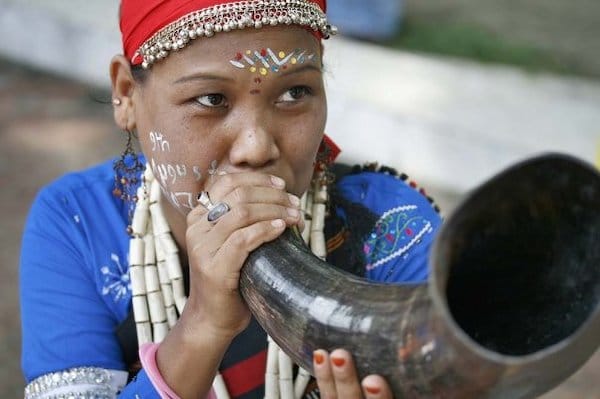On May 17, 2021 three unarmed adivasi (aboriginal) protesters were killed by Indian police near the village of Silger, in the central Indian forests in the State of Chhattisgarh. They were protesting the building of a fortified camp by the Central Reserve Police Force (CRPF) on their land and without their consent. A movement in protest has convulsed Chhattisgarh, and culminated in a mass rally at Silger on the one year anniversary of the murders. Monthly Review author Saroj Giri, who teaches Politics at the University of Delhi, travelled to the forest for the event and has sent us his thoughts on its considerable significance. Eds.
It is quite common to think of the black man in the United States who finds himself in a moment of danger. But let us talk about the adivasi people in India who are in a similar situation. Not just danger, but they–their life, culture, forests and land–are facing a situation of accelerated danger.
In such a situation, as one can imagine, one tends to react with a bodily presence of mind, with heightened stimulation. You respond not really in a strategic or tactical manner, calmly thinking about winning but almost in a reflex, a corporeal reaction from each and every pore–which might still help you win. Your responses are immediate and unthought, but precise and cutting. In such a world, each object displays infinite powers even in their finite objectivity–a kind of corporeal enervation. What looks like a finite action in such a moment might be one of divination, utterly sublime.
In Frantz Fanon, the black man is in the moment of danger, of nonbeing and declivity. But this is not about being cast into victimhood and oppression. For it is like a prelude, the springboard from which a revolutionary subjectivity is born. Fanon writes,
there is a zone of nonbeing, an extraordinarily sterile and arid region, an utterly naked declivity where an authentic upheaval can be born.
The moment of accelerated danger and the zone of nonbeing are precisely what captures the situation in the adivasi lands of central India today. Places like Bastar, Gadchiroli in the Dandakaranya forests. But what you also find is that this is where “an authentic upheaval can be born”–or is born. The adivasi population has conjured itself into a form of divine corporeality and an authentic upheaval, speaking right from their pores and capillaries. Their culture, the struggle for the defence of adivasi culture, is enervated into a defence of their very existence. Never before has the question of culture become so fundamentally a question of the very existence of a people.
Culture whose defence necessitates an armed struggle to uphold the existence of the people is not culture in any simple sense. It is now a culture which plays a larger role of blocking the process of capital accumulation, undoing accumulation through dispossession, stalling capital in its tracks.
“What will you do with adivasi (indigenous or aboriginal) culture, if there is no adivasi, if your very existence is under threat?” These are the words of Surju Tikam, a key member of the mainstream Sarva Adivasi Samaj (United Indigenous Society) in Chhattisgarh. He shared this thought in a conversation we were having in Silger on the 16th May 2022.
Thousands of adivasi masses had converged in Silger in Central India to mark one year of their movement against the killing of five people last year. The movement under the banner of Moolvasi Bachao Manch (Aboriginal Peoples Platform) is in protest against the paramilitary camps and disproportionately wide roads built for further infiltration in the region. The entire area is rich in minerals and ore that are being eyed by the rapacious corporations. Crushing the rebel Maoist movement and enabling “development” in the area is the stated rationale of the state for the spiralling militarisation and road building. Earlier, these “area domination” exercises took place under the rubric of Operation Green Hunt, now under Operation Samadhan-Prahar, of the Indian state.
What did Surju Tikam mean by his remarks?
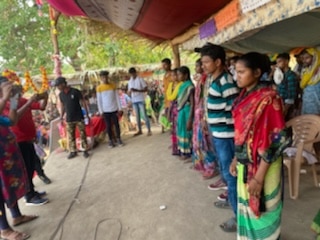 He meant that existence must be defended. The Silger resistance is about defending the very existence of the adivasi as a people in their land and habitat–and not just defending an abstract aboriginal “culture”.
He meant that existence must be defended. The Silger resistance is about defending the very existence of the adivasi as a people in their land and habitat–and not just defending an abstract aboriginal “culture”.
The refusal to turn one’s culture into a valorised good in the commodity spectacle, in the market of multiculturalism and non-binary, “two-spirit” branding–means that culture would now turn into a solid basis for its own defence. Culture becomes the terrain of resistance and must attune itself to the laws of war.
Nor is it about culture as “radical art” or the avant garde “political art”, detached from the living reproduction of society, the mode of interchange between humans and nature. How to bury the dead, welcome the new born, the rites of marriage, harvest and festivals–such is the culture at stake here, furthest from the deracination typical of “radical art” today. Hence existence is vital. But the defence of existence cannot be done without culture. There comes a moment when culture and war of resistance becomes inseparable.
Silger today stands for adivasi culture which is inseparable from the existence of the adivasi people as adivasi, from their astitva (existence). This is “existence” which is more fundamental than even self-determination and autonomy–more in tune with the Black Panther’s emphasis on the existence and self-defence of the black people in the U.S..
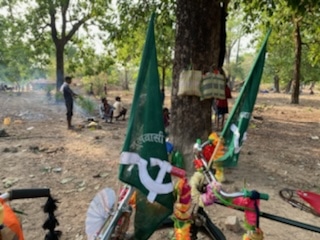 Culture, defetishized and tied with existence, seems to make capital nervous and desperate. For here is culture which denies capital that on which it feeds, the vital mineral resources and primary materials and “unfree labour”. Remember how the anthropologist Maurice Godelier formulated that in certain indigenous societies, kinship relations themselves take the form of production relations. In Bastar with the movement in Silger, we have a case where kinship relations, being the very form of production relations, now as culture interlaced with existence in the ongoing resistance, work towards impeding the penetration of big capital and mining interests.
Culture, defetishized and tied with existence, seems to make capital nervous and desperate. For here is culture which denies capital that on which it feeds, the vital mineral resources and primary materials and “unfree labour”. Remember how the anthropologist Maurice Godelier formulated that in certain indigenous societies, kinship relations themselves take the form of production relations. In Bastar with the movement in Silger, we have a case where kinship relations, being the very form of production relations, now as culture interlaced with existence in the ongoing resistance, work towards impeding the penetration of big capital and mining interests.
Adi-vasi, as the first (adi-) inhabitants are the first people not just in the temporal or chronological sense, but also in the spatial sense–that is, they started human settlements and social life in the region. The spatial aspect is more complicated as surely the adivasi way of life, even if it were chronologically the first, is not the only possible way of life and, moreover, it is itself subject to change and motion. There is no reason to romanticize the adivasi way of life. And yet in the dynamic political battle raging in Bastar today the convergence of culture and existence as a bulwark against capital accumulation means that the adivasi way of life is a political banner of resistance and a way of life rolled into one. The Moolvasi Bachao Manch is right in defending it.
There is another dimension. For what is inescapable, in the Indian debate on indigeneity, is that “adivasi” denotes a prior register of resisting the Hindu-Brahminical hegemonic social-civilisational framework which aligns closely with the ruling establishment.
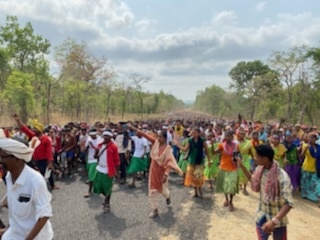 We know where B. R. Ambedkar identified the revolution and counter revolution in India. He identified it in what he called the “Buddhist revolution and Brahminical counter-revolution” going back to ancient India. Then you have Jyotirao Phule who would propose the almost socio-civilisational divide between the Aryan invaders who defeated and subjugated the native adivasis and instituted the Brahminical caste system. The Buddhist is not to be conflated with adivasi. But there are good reasons to believe that, in the struggle between contending forces in Indian civilisation, the Buddhists were on the side of the adivasi in opposition to the Brahminical/Aryan social order.
We know where B. R. Ambedkar identified the revolution and counter revolution in India. He identified it in what he called the “Buddhist revolution and Brahminical counter-revolution” going back to ancient India. Then you have Jyotirao Phule who would propose the almost socio-civilisational divide between the Aryan invaders who defeated and subjugated the native adivasis and instituted the Brahminical caste system. The Buddhist is not to be conflated with adivasi. But there are good reasons to believe that, in the struggle between contending forces in Indian civilisation, the Buddhists were on the side of the adivasi in opposition to the Brahminical/Aryan social order.
Now these civilisational-socio-ideological formulations must be provided a material basis in the active relationship between culture and the defence of existence. They must be freed from the essentialist racialization of Aryan vs. non-Aryan and cast onto the furnace of capitalist accelerationism and class formation which is not about fixating on a sociological working class as a separate category, but one which striates the whole social body–this means that class forces would also internally differentiate and constitute the adivasi or the bahujan (lower caste majority) itself or for that matter the Brahminical sections. This is not about the working class as a group to be venerated but class forces that animate and structure the social body, including existence and culture.
The resistance against military camps and spooky roads in Silger (as also in several other parts of central India) is therefore of major significance today.
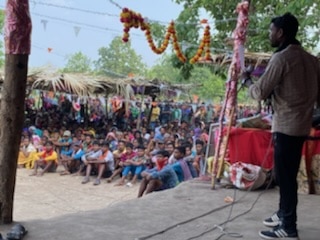 Silger poses the question of culture in such a way that it prevents the dissolution of the adivasi people into the mass of heavily underpaid cheap labour dotting the industrial towns and cities of India. Here is a cultural resistance which stops feeding the machine of capitalist accumulation with mineral resources and cheap precariat labour.
Silger poses the question of culture in such a way that it prevents the dissolution of the adivasi people into the mass of heavily underpaid cheap labour dotting the industrial towns and cities of India. Here is a cultural resistance which stops feeding the machine of capitalist accumulation with mineral resources and cheap precariat labour.
This also means that it is not about opposing all mining or “development” as such. It is about opposing mining in its present form–for even within adivasi culture/existence, we find the persistence of living traditions of mining and metallurgy. Walk into any fancy high-end store in Indian cities and you will find the famous artefacts of adivasi metalworks, most famously, the Dhokra art. Art galleries in cities too display such artefacts and similar archaeological finds from the region.
Cabral, Fanon and the armed struggle
Surju Tikam’s formulation connecting culture with existence and the war of resistance, resonates with the views of Amilcar Cabral from Africa during the 1960-70s who was faced with a similar situation with regards to the culture and existence of the people. In his famous essay called “National liberation and Culture” (1970), Cabral foregrounded the question of culture and the armed struggle of the people against Portuguese colonial domination in Guinea-Bissau. We can also think of Frantz Fanon’s emphasis on culture and its interrelationship with the anti-colonial resistance, most famously the role of the Islamic veil worn by women in the armed struggle in Algeria. In his The Wretched of the Earth, Fanon asked:
There now remains one fundamental question. What is the relationship between the struggle, the political or armed conflict, and culture?
Cabral is very aware that complete domination of a people “can be maintained only by the permanent, organized repression of the cultural life of the people concerned”. And then,
For, as long as there continues to exist a part of these people retaining their own cultural life, foreign domination cannot be sure of its perpetuation.
But culture might as well escape enslavement and can serve as the basis of resistance and armed struggle. He writes:
At any moment, depending on internal and external factors determining the evolution of the society in question, cultural resistance (indestructible) may take on new forms (political, economic, armed) in order fully to contest foreign domination.
At the same time, the armed struggle also further develops the culture in new and creative directions: “the armed liberation struggle is not only a product of culture but also a determinant of culture”. So the armed struggle also influences culture thereby strengthening the relation between culture and existence of the people.
Culture is not just the basis for the armed struggle, but also “an inexhaustible source of courage, of material and moral support, of physical and psychic energy which enables them to accept sacrifices—even to accomplish ‘miracles’.”
There is also a warning here as culture can also entrap the resistance struggle:
But equally, in some respects, culture is very much a source of obstacles and difficulties of erroneous conceptions about reality, of deviations in carrying out duty, and of limitations on the tempo and efficiency of a struggle that is confronted with the political, technical and scientific requirements of a war.
There are of course many differences between the situation in Africa in the 1970s and what is unfolding in central India today. And yet in the very concrete specificity of the adivasi situation today there is so much resonance of the precise relation between culture and existence, culture and the war of liberation of the people, if not as nation, but as a people. That Cabral’s views resonated so much with what Surju Tikam was saying is not entirely incidental.
As a mainstream platform, the Sarva Adivasi Samaj in Chhattisgarh today has members from the adivasi community who are from both the lower classes and the middle class and a small section of the more moneyed upper classes. It is split between focusing one-sidedly on defending adivasi culture in an abstract or essentialised culturalist sense, or integrating the culture question with that of existence. If it does the latter, that is integrates culture with existence, then it might have to reckon with the ongoing battle and armed struggle in Bastar. In order to avoid the question of armed struggle, it might be tempted to close its eyes and only focus on an essentialised and abstract idea of culture, removed from the lives of millions of adivasi masses—that however might not be the right thing to do.
The message from Silger is to go forward on the path of a strong people’s resistance movement which would uphold adivasi culture without abandoning the task of defending the very existence of the adivasi people without displacing and splintering them into the ranks of the impoverished urban proletariat. Ambedkar, Phule, Kabir, Ravidas all emphasised on the moolvasi’s rejection of Brahminical ideology–now Silger takes that struggle, and its cultural-ideological fight, into the very terrain of big capitalist interests and state repression that profess the idea of “development” and “growth”. Silger, as the open movement of the masses, is able to “balance” itself between the state and the Maoists and yet is able to attack the overwhelming injustice and exceptional violence of the state and its connivance with big capitalist interests.

